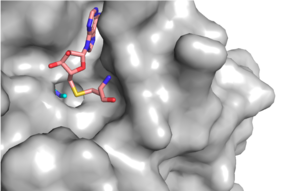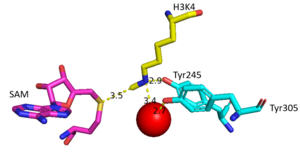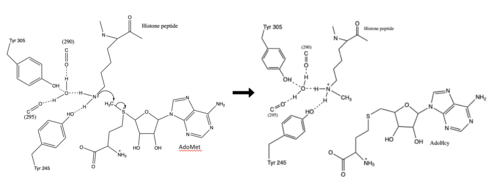User:Ashley Crotteau/Sandbox1
From Proteopedia
(Difference between revisions)
| Line 21: | Line 21: | ||
The most notable feature of the HKMT is the presence of the lysine access channel as the active site. The cofactor and peptide substrate are actually located on opposite sides of the SET domain but are connected through this narrow channel.<ref name="Xiao" /> This channel allows these two components to interact and complete the methyltransfer. The active site in general is considerably tyrosine rich. Residues Tyr245, His297, Ser268, Tyr305, Tyr335, and Tyr337 all help to shape the active site and the channel.<ref name="Xiao" /> The cofactor involved, SAM, provides the methyl for methylation of the lysine on its sulfur atom. | The most notable feature of the HKMT is the presence of the lysine access channel as the active site. The cofactor and peptide substrate are actually located on opposite sides of the SET domain but are connected through this narrow channel.<ref name="Xiao" /> This channel allows these two components to interact and complete the methyltransfer. The active site in general is considerably tyrosine rich. Residues Tyr245, His297, Ser268, Tyr305, Tyr335, and Tyr337 all help to shape the active site and the channel.<ref name="Xiao" /> The cofactor involved, SAM, provides the methyl for methylation of the lysine on its sulfur atom. | ||
| - | [[ | + | [[Image:Water.PNG|300 px|right|thumb|Figure 2: Water being utilized in the active site]] |
The beta hairpin stabilizes the <scene name='81/811707/Beta_hairpin_stabilizing_tyrs/1'>conformation of Tyr335 and Tyr337</scene>, while also shaping one side of the channel which the peptide binds to (Figure 1).<ref name="Xiao" /> The <scene name='81/811707/Peptide_binding_site/1'>peptide binding groove</scene> is composed of residues 255-268.<ref name="Xiao" /> Lysine would have trouble coming down into the active site in its charged form, but it is facilitated by the faces of the flanking tyrosines.<ref name="Xiao" /> The orientation of the lysine is such that the amine-methyl bond is aligned towards the sulfur on SAM so that it can provide the methyl. There is an important water in the active site (Figure 2) as well that acts as a stabilizer for lysine, and helps to shift the lone pair on the nitrogen towards the sulfur of SAM. <ref name="Xiao" /> | The beta hairpin stabilizes the <scene name='81/811707/Beta_hairpin_stabilizing_tyrs/1'>conformation of Tyr335 and Tyr337</scene>, while also shaping one side of the channel which the peptide binds to (Figure 1).<ref name="Xiao" /> The <scene name='81/811707/Peptide_binding_site/1'>peptide binding groove</scene> is composed of residues 255-268.<ref name="Xiao" /> Lysine would have trouble coming down into the active site in its charged form, but it is facilitated by the faces of the flanking tyrosines.<ref name="Xiao" /> The orientation of the lysine is such that the amine-methyl bond is aligned towards the sulfur on SAM so that it can provide the methyl. There is an important water in the active site (Figure 2) as well that acts as a stabilizer for lysine, and helps to shift the lone pair on the nitrogen towards the sulfur of SAM. <ref name="Xiao" /> | ||
Revision as of 17:59, 5 April 2019
H. sapiens Lysine Methyltransferase, SET 7/9
| |||||||||||
References
- ↑ 1.0 1.1 1.2 1.3 1.4 1.5 1.6 Schubert HL, Blumenthal RM, Cheng X. Many paths to methyltransfer: a chronicle of convergence. Trends Biochem Sci. 2003 Jun;28(6):329-35. PMID:12826405
- ↑ 2.0 2.1 2.2 2.3 2.4 2.5 Yeates TO. Structures of SET domain proteins: protein lysine methyltransferases make their mark. Cell. 2002 Oct 4;111(1):5-7. PMID:12372294
- ↑ 3.0 3.1 3.2 3.3 3.4 3.5 3.6 3.7 3.8 Xiao B, Jing C, Wilson JR, Walker PA, Vasisht N, Kelly G, Howell S, Taylor IA, Blackburn GM, Gamblin SJ. Structure and catalytic mechanism of the human histone methyltransferase SET7/9. Nature. 2003 Feb 6;421(6923):652-6. Epub 2003 Jan 22. PMID:12540855 doi:10.1038/nature01378
- ↑ 4.0 4.1 Huang S, Shao G, Liu L. The PR domain of the Rb-binding zinc finger protein RIZ1 is a protein binding interface and is related to the SET domain functioning in chromatin-mediated gene expression. J Biol Chem. 1998 Jun 26;273(26):15933-9. PMID:9632640
- ↑ 5.0 5.1 doi: https://dx.doi.org/10.1016/C2014-0-02189-2
- ↑ https://en.wikipedia.org/wiki/SET_domain#Structure
Student Contributors
Ashley Crotteau
Parker Hiday
Lauren Allman



